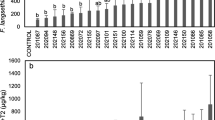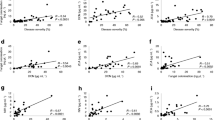Abstract
Experiments were conducted to determine the extent of Fusarium langsethiae infection in wheat, barley and oats grown under identical experimental conditions. In total, four experiments were conducted with both winter and spring sown experiments at two locations. The amount of F. langsethiae infection was determined by quantifying F. langsethiae DNA and quantifying the combined concentration of the trichothecene mycotoxins HT-2 and T-2 (HT-2 + T-2) in cereal head fractions (grain and rest of the head) after threshing at harvest. Results of the study showed that under identical experimental conditions, oats had the highest F. langsethiae DNA and HT-2 + T-2 concentrations compared to wheat and barley. This indicates that the high levels detected on UK oats compared to wheat and barley from surveys of commercial crops is a consequence of genetic differences rather than differences in agronomy applied to the cereal species. The concentration of HT-2 and T-2 per unit of F. langsethiae DNA in oats compared to wheat and barley was also significantly higher indicating host differences in either the stimulation of HT-2 and T-2 production or in the metabolism of HT-2 and T-2. The study also showed that the proportion of F. langsethiae DNA in threshed grains was significantly lower than that in the rest of the cereal head.









Similar content being viewed by others
References
Anon (2013). Commission recommendation on the presence of T-2 and HT-2 toxin in cereals and cereal products. Official Jounal of the European Union, L91, 12–15.
Cowger, C., & Arellano, C. (2013). Fusarium graminearum infection and deoxynivalenol concentrations during development of wheat spikes. Phytopathology, 103, 460–471.
Edwards, S. G. (2007). Investigation of Fusarium mycotoxins in UK barley and oat production. HGCA Project Report No. 415. London: HGCA.
Edwards, S. G. (2009). Fusarium mycotoxin content of UK organic and conventional barley. Food Additives and Contaminants, 26, 1185–1190.
Edwards, S. G. (2012). Improving risk assessment to minimise Fusarium mycotoxins in harvested oats and malting barley. HGCA Project Report No. RD-2007–3332. London: HGCA.
Edwards, S. G., Barrier-Guillot, B., Clasen, P. E., Hietaniemi, V., & Pettersson, H. (2009). Emerging issues of HT and T-2 toxins in European cereal production. World Mycotoxin Journal, 2, 173–179.
Edwards, S. G., Imathiu, S., Ray, R. V., Back, M., & Hare, C. M. (2012). Molecular studies to identify the fusarium species responsible for HT-2 and T-2 mycotoxins in UK oats. International Journal of Microbiology, 156, 168–175.
Imathiu, S. M., Edwards, S. G., Ray, R. V., & Back, M. A. (2013). Fusarium langsethiae - a HT-2 and T-2 toxins producer that needs more attention. Journal of Phytopathology, 161, 1–10.
Lattanzio, V. M., Visconti, A., Haidukowski, M., & Pascale, M. (2012). Identification and characterization of new fusarium masked mycotoxins, T2 and HT2 glycosyl derivatives, in naturally contaminated wheat and oats by liquid chromatography-high-resolution mass spectrometry. Journal of Mass Spectrometry, 47, 466–475.
Lemmens, M., Scholz, U., Berthiller, F., Dall’ Asta, C., Koutnik, A., Schuhmacher, R., Adam, G., Buerstmayr, H., Mesterha’zy, A., & Krska, R. (2005). The ability to detoxify the mycotoxin deoxynivalenol colocalizes with a major quantitative trait locus for Fusarium head blight resistance in wheat. Molecular Plant-Microbe Interactions, 18, 1318–1324.
Meng-Reiterer, J., Bueschl, C., Rechthaler, J., Berthiller, F., Lemmens, M., & Schuhmacher, R. (2016). Metabolism of HT-2 toxin and T-2 toxin in oats. Toxins, 8, 364.
Nathanail, A. V., Varga, E., Meng-Reiterer, J., et al. (2015). Metabolism of the fusarium mycotoxins T-2 toxin and HT-2 toxin in wheat. Journal of Agricultural and Food Chemistry, 63, 7862–7872.
Opoku, N. (2012). Study of Fusarium langsethiae infection in UK cereals. Shropshire, UK: A PhD thesis submitted to the Harper Adams University.
Opoku, N., Back, M., & Edwards, S. G. (2013). Development of Fusarium langsethiae in commercial cereal production. European Journal of Plant Pathology, 136, 159–170.
Orlando, B., Barrier-Guillot, B., Gourdain, E., & Maumene, C. (2010). Identification of agronomic factors that influence the levels of T-2 and HT-2 toxins in barley grown in France. World Mycotoxin Journal, 3, 169–174.
Veprikova, Z., Vaclavikova, M., Lacina, O., Dzuman, Z., Zachariasova, M., & Hajslova, J. (2012). Occurrence of mono- and di-glycosylated conjugates of T-2 and HT-2 toxins in naturally contaminated cereals. World Mycotoxin Journal, 5, 231–240.
Wilson, A., Simpson, D., Chandler, E., Jennings, P., & Nicholson, P. (2004). Development of PCR assays for the detection and differentiation of Fusarium sporotrichioides and Fusarium langsethiae. Microbiology Letters, 233, 69–76.
Acknowledgements
The first author acknowledges funding of a PhD studentship from Harper Adams University and AHDB Cereals and Oilseeds (RD-2008-3479).
Author information
Authors and Affiliations
Corresponding author
Ethics declarations
Conflict of interest
The authors declare that they have no conflict of interest.
Rights and permissions
About this article
Cite this article
Opoku, N., Back, M.A. & Edwards, S.G. Susceptibility of cereal species to Fusarium langsethiae under identical field conditions. Eur J Plant Pathol 150, 869–879 (2018). https://doi.org/10.1007/s10658-017-1329-z
Accepted:
Published:
Issue Date:
DOI: https://doi.org/10.1007/s10658-017-1329-z




